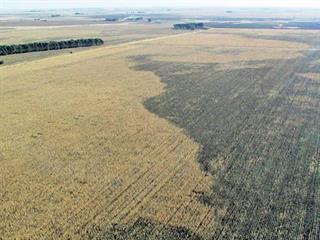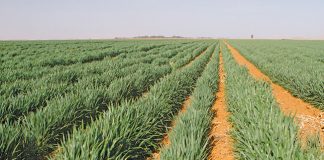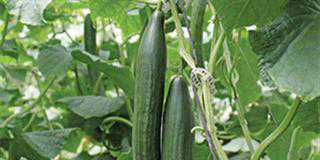
However, as soya bean production gradually spreads westwards across the warmer, drier parts of the country, new soya bean pest and disease challenges will emerge there as well.
This is so especially in no-till operations. Two to watch out for are sudden death syndrome (SDS) and charcoal rot.
Sudden death
SDS is a new soya bean disease. Already common in the US, it recently found its way into South Africa and is currently mainly confined to Mpumalanga.
It’s caused by the fungal pathogen Fusarium virguliforme and gives rise to interveinal chlorosis and necrosis on the leaves. It can affect an entire soya bean land, but usually occurs as scattered areas of infection.
“Typical symptoms are leaf loss, while the stems remain green and the leaf petioles remain attached,” explains Dr Rikus Kloppers, senior manager of crop services with Pannar Seed. “SDS infection also leaves blue masses of conidia on the surface of the plant’s root system.”
Plant pathologists are unsure how far SDS has spread in South Africa and have asked farmers to urgently report suspected cases to them.
In the meantime, options for managing SDS include sourcing any available SDS-resistant soya bean varieties, preventing extended cool and wet conditions from developing in soya bean lands, rotating soya beans with at least two consecutive years of a grain crop, and treating seed against fungal pathogens.
Unfortunately, says Kloppers, no seed treatment to prevent SDS has yet been registered, but this option is being investigated. Leaf-applied fungicides cannot control the disease as the plant is already infected at an early stage of its development.
In the US, SDS has been found to be associated with soya bean cyst nematode (SCN), and using appropriate nematicides against SCN appears to reduce SDS infection there. SCN has not yet been found in South Africa, though.
Charcoal rot
Charcoal rot (Macrophomina phaseolina) is potentially one of the most important diseases of soya beans in South Africa, warns Kloppers.
“It typically emerges when soya bean plants are stressed for moisture at grain drying time. It isn’t new to our country, but it has the potential to dramatically increase its impact as commercial soya bean production extends into the drier central and western parts.”
As charcoal rot also infects maize, sorghum, sunflower and dry beans, none of these major summer crops can be rotated with soya beans to break its cycle in a land. Its inoculum can survive in the soil for many years, particularly in crop residue left on the surface.
Symptoms of charcoal rot include yellow-brown leaves that remain attached to the plant stem, early death of infected plants, and grey discolouration of stems and roots.
Managing charcoal rot in soya beans requires an integrated approach that includes reducing the plant population, promoting soil moisture conservation, matching seeding rates to soil water availability, planting tolerant soya bean varieties, and rotating soya beans with crops not susceptible to charcoal rot.
*Read more about managing diseases in no-till soya beans.













